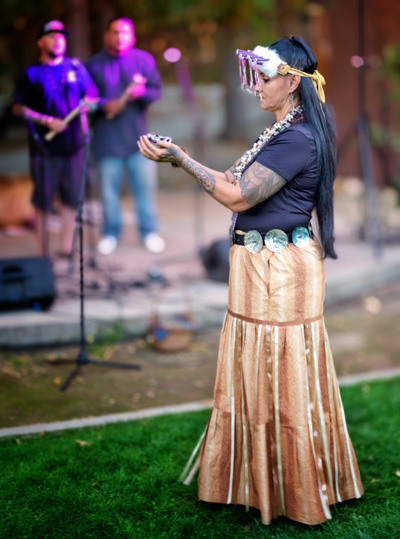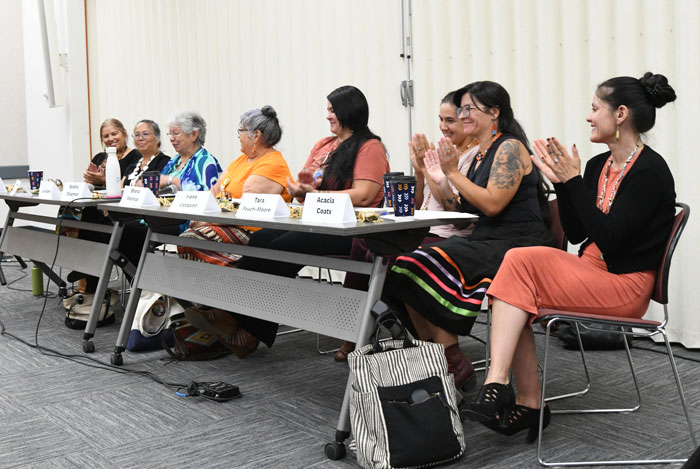‘allǝmǝksǝmaa — I’m listening
October 17, 2024 – Article by Andra Kovacs – Tribal Council Chairwoman Sandra Chapman sat in the center of a powerful line of eight indigenous women on Monday night. She looked around at the audience of over 75 community members in the Board of Supervisors Chambers, who came to listen to the inter-tribal representatives and leadership share an open discussion on Tribal Sovereignty and Democracy.
(Pictured) Panelists Heather Bernikoff, Jeanette Acosta, Lois Martin, Sandra Chapman, Shona Medinas, Irene Vasquez, Tara Fouch-Moore and Acacia Coats (left to right), share an open discussion on Tribal Sovereignty and Democracy on Monday night. Photo credit: Mike Ahmadi.
Chapman opened her palm to gesture towards the audience, and then towards her fellow panel speakers.
“We can’t stop because we’re not federally recognized,” Chapman said, scanning the room. “You guys recognize us, don’tcha? These people here recognize us. And that’s what counts, not the government. It’s the people.”
And she was right. The room was filled with colleagues, relatives, friends, partners, leaders, and familiar faces. They all showed up for this kick-off event for Aytu’ Kannəŋ Pachenti’ – All My Relatives – a week-long free cultural event series centering and celebrating indigenous sovereignty. It was one of 14 Cultural Week of Action anchor projects being held simultaneously across the nation. Organized and funded by Americans for the Arts and RaceForward, the Cultural Week of Action is a new initiative designed to connect communities across the United States as they affirm democratic ideals through arts, culture and creativity.
The Mariposa County Arts Council teamed up with Southern Sierra Miwuk Nation and the Mariposa County Library to facilitate five days of diverse gatherings that welcomed community members to participate and learn about contemporary tribal practices while also presenting documented evidence challenging the Bureau of Indian Affairs’ refusal to grant Federal Acknowledgment to the SSMN.
The events brought a new light to the complex and discontenting reality which Chapman acknowledged plainly during the panel discussion: that the local community recognizes and respects the SSMN as a tribe, weaving them into the fabric of local democracy, however they remain unrecognized by the federal government, causing them profound and systemic resource scarcity.
The panel was facilitated by Clay River, a Director of Programs and Projects and Lead Teaching Artist for the Arts Council as well as the co-producer of this Cultural Week of Action. Each panelist introduced themselves in their native language, and spoke to what Tribal Sovereignty through Federal Recognition would mean for their community.
Former Tribal Council Director Irene Vasquez and Chapman both discussed the many practical benefits, supports and services that would come for their future generations. Access to wildfire and pandemic relief, and funding for housing and education were mentioned. Vasquez described how along with the benefits, it would simply be a meaningful gesture of respect from the government.
“What they’re doing is erasing a culture,” said the Keynote Panelist Jeanette Acosta, who is, among many things, a Program Associate at the National Organization of Asians & Pacific Islanders Ending Sexual Violence. She spoke on culture, what it means for the government to enact violence upon it, and what it means for it to survive.
Former Tribal Council Director and Advisory Council member for MACT Health, Lois Martin, paused to acknowledge that even without recognition, as a tribe they have accomplished a lot, and their culture lives on.
“Our sovereignty has never been lost,” Martin said. “Maybe it was done in secret, but we still did our language, our ceremony, and practiced our ways.”
Tribal Council Director and co-producer of this Cultural Week of Action, Acacia Coats, shared directly and emotionally about her family’s struggle and her quest to end the cycle of harm. She shared her prayers for her children and elders, and that this fight for recognition is the fight for ending generational trauma.
Heather Bernikoff, the Pollinator and Wildlife Habitat Program Manager and Tribal Liaison echoed this sentiment, saying simply, “healing happens when acknowledgement happens.” As a member of the Yaqui Tribal Community in Southern California, she went on to add that “as a person on [SSMN’s] lands, my role is to help them fulfill their visions and goals.”
Former Tribal Council Director and Owner of Mariposa FryBread Company Shona Medinas said that all their goals are for the next generation. “We want them to get stronger, know more of our language, more of our ways.”
And the visions and goals spoken that night were a chorus of motherhood, daughterhood, land stewardship, ceremony,  justice for their elders, health, happiness, and an end to suffering. They wanted their people and culture to thrive.
justice for their elders, health, happiness, and an end to suffering. They wanted their people and culture to thrive.
(Pictured) Genevieve Lemaster, honored Miwuk Dancer, offers medicine as a part of her dance on Friday evening's event. Photo credit: Mike Ahmadi.
wǝkstii ‘etchammǝ’ — Let’s (You and I) Go Outside
“The cultural world and the natural world are intrinsically entwined,” Acosta said during Monday’s discussion.
And this concept was made visible during Tuesday’s Guided Walk on the Mariposa Creek Parkway with SSMN’s Land Steward and Lead Pollinator, Shana Saucedo and Tribal Council Secretary and Land and Water Stewardship Director Tara Fouch-Moore.
Fouch-Moore, who also spoke on Monday’s panel, pointed to grinding holes near the bridge as the group walked by. “Our people were entwined with this place. It’s evidence written into stone.”
They shared stories of beavers moving back to the creek after stewardship teams removed blackberry overgrowth. They shared stories of how the unharvested elderberries left to dry on the tall stalks support migrational songbirds through Fall. They described how they share similar needs with the non-human relatives of this land; they rely on the same plants. And with respect for that shared reliance, they build a harvesting relationship.
tinnǝy ‘enhǝsǝǝ — What Are You Making?
During Wednesday’s Cultural Arts Day, Chapman guided a workshop on Sourberry Mash Making, which taught similar values of respect and relationality with the plants one harvests. She showed the group a basket woven with Sourberry stalks and ground the berries from the plant, so everyone could taste its red, tart flesh.
When she was asked where Sourberry grows, she didn’t explain the plant’s habitat or growing zone. Instead, she answered by describing very specific patches she knows of in the area. She gave landmarks, road names, and shared stories of when she harvested from them. This, it seems, is a part of what Fouch-Moore meant by a harvesting relationship: it’s about knowing the specific plants on a personal basis.
Other workshops on Wednesday included beading with Saucedo and Cultural Preservationist Jazzmyn Gegere, medicine pouch making with River, and learning children’s Miwuk songs with Coats.
Each culture keeper generously shared their crafts, inviting participants to witness and learn from their devotion and relationship with beads, leather, medicine, drum and song.
manako lee neeko ‘ok — Who Are These People?
On Thursday evening, the attention shifted to political allyship during the Call to Action at the Mariposa County Library. Each seat was filled with community members, eager to demonstrate their support for SSMN’s Petition for Federal Recognition. Coats and River explained the context, history, and current strategy for the tribe’s political struggle. There was a strong focus on the inherent support of healthy relationships, as participants were given materials for writing a letter to the Office of Federal Recognition.
Therapist and Wellness Educator and member of the Eastern Band Cherokee, Sharon Whitefawn, hosted a community wellness circle during the evening’s event.
“Bringing healing to the original people on this land brings healing to us all,” Whitefawn said, explaining that they seek to embed medicine into everything that they do– including the bureaucratic work.
hǝyneynǝmaa ‘ikoyyo kalaanetoy — I Want to Watch Them Dance
As the end of a culminating week of action, learning, listening, connecting and relationship building, Friday evening saw a powerful and energetic event at the Arts Park, with Intertribal Dance, Cultural Arts Celebration and Dinner.
There were over a dozen dancers from various traditions, contemporary and traditional musicians, and poets. Dinner was served by Medinas’ Mariposa FryBread Company, and the audience of over 150 community members sampled first foods like acorn mush, pine nuts and elderberry tea.
It was explained to the audience that the dances were offerings, not performances. And an offering it was– one of movement, of intergenerational hope, of strength and of story. There were dances that told stories of crows through their movements. There were stories in the regalia– ribbons that swayed just as grass does on the wind. There was drumming from the Fresno Aztec Dance Club that seemed to shake the earth, telling the story of their people’s power. And finally, there was the story of community, as the night ended with a round dance– every dancer and audience member grasping hands and moving together through the Arts Park. The dance ended in a circle on the stage, and the celebration officially closed with laughter, hugs and many “thank you’s.”
While the Cultural Week of Action has come to an end, it was a reminder that the relationships, education and connection to this place and its people is an ever-present fixture in this community’s health, democracy and story.
Source & photos: Mariposa County Arts Council








